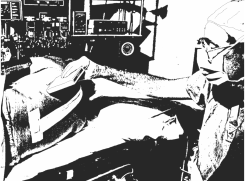
A striking example of perfusion effects can be demonstrated by com-
promise of circulation to the arm. A complete or partial occlusion of the
artery in the upper arm will result in an immediate drop in hand tem-
perature, and detectable in less than 30 seconds from the time of oc-
clusion. The rapid response and the simplicity of infrared measure-
ments make the technique effective in the hospital environment.
III. Clinical Applications
The following is a brief synopsis of a number of clinical applications for
surface temperature measurements. These subjects are not covered
in sufficient detail to be used for clinical protocols and are intended to
be general indications for the use of infrared temperature measure-
ments for clinical purposes. Because of the sensitivity of surface
temperatures to the environment, it is important that certain precau-
tions be followed in making surface temperature measurements. They
are:
1. Provide for adequate equilibration time in the room environment at
which the measurements will take place.
2. Protect the patient from drafts and exposure to cold surfaces (win-
dows in winter).
3. Consider the use of a skin surface marker to ensure the measure-
ment sites are repeatable.
Regional Blocks
The effectiveness of regional
blocks can be monitored using the
change in surface temperature
due to sympathetic vasodilation of
the tissue in the blocked area,
eliminating the subjective pin prick
assessment method. Depending
on the type and location of the
block, one can expect to see a
temperature increase in the order
of 1 to 1.5°C on the skin surface
of the blocked area in 10 to 30
minutes after the injection of the
blockade drug.
In a recent study on sympathetic blockade, Chamberlain et al (1986)
1
measured the dynamic pattern of skin changes during spinal anesthe
Using the DermaTemp to verify the
geography of the block
20


















